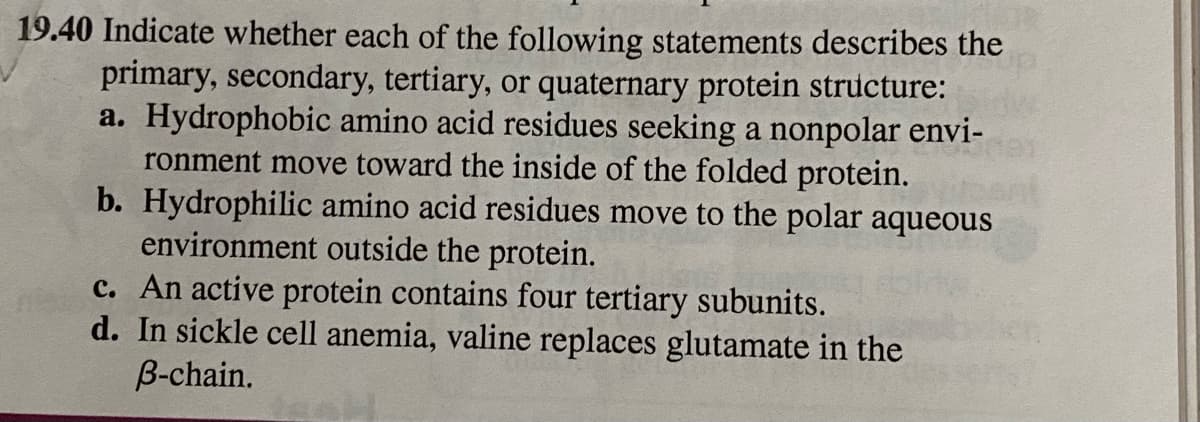19.40 Indicate whether each of the following statements describes the primary, secondary, tertiary, or quaternary protein structure: a. Hydrophobic amino acid residues seeking a nonpolar envi- ronment move toward the inside of the folded protein. b. Hydrophilic amino acid residues move to the polar aqueous environment outside the protein. c. An active protein contains four tertiary subunits. d. In sickle cell anemia, valine replaces glutamate in the B-chain.
19.40 Indicate whether each of the following statements describes the primary, secondary, tertiary, or quaternary protein structure: a. Hydrophobic amino acid residues seeking a nonpolar envi- ronment move toward the inside of the folded protein. b. Hydrophilic amino acid residues move to the polar aqueous environment outside the protein. c. An active protein contains four tertiary subunits. d. In sickle cell anemia, valine replaces glutamate in the B-chain.
Biochemistry
9th Edition
ISBN:9781319114671
Author:Lubert Stryer, Jeremy M. Berg, John L. Tymoczko, Gregory J. Gatto Jr.
Publisher:Lubert Stryer, Jeremy M. Berg, John L. Tymoczko, Gregory J. Gatto Jr.
Chapter1: Biochemistry: An Evolving Science
Section: Chapter Questions
Problem 1P
Related questions
Question

Transcribed Image Text:19.40 Indicate whether each of the following statements describes the
primary, secondary, tertiary, or quaternary protein structure:
a. Hydrophobic amino acid residues seeking a nonpolar envi-
ronment move toward the inside of the folded protein.
b. Hydrophilic amino acid residues move to the polar aqueous
environment outside the protein.
c. An active protein contains four tertiary subunits.
d. In sickle cell anemia, valine replaces glutamate in the
B-chain.

Transcribed Image Text:19.36 What type of interaction would you expect between the follow-
ing groups in a tertiary structure?
a. phenylalanine and isoleucine
c. asparagine and tyrosine
b. aspartate and histidine
d. alanine and proline
Expert Solution
This question has been solved!
Explore an expertly crafted, step-by-step solution for a thorough understanding of key concepts.
This is a popular solution!
Trending now
This is a popular solution!
Step by step
Solved in 5 steps

Knowledge Booster
Learn more about
Need a deep-dive on the concept behind this application? Look no further. Learn more about this topic, biochemistry and related others by exploring similar questions and additional content below.Recommended textbooks for you

Biochemistry
Biochemistry
ISBN:
9781319114671
Author:
Lubert Stryer, Jeremy M. Berg, John L. Tymoczko, Gregory J. Gatto Jr.
Publisher:
W. H. Freeman

Lehninger Principles of Biochemistry
Biochemistry
ISBN:
9781464126116
Author:
David L. Nelson, Michael M. Cox
Publisher:
W. H. Freeman

Fundamentals of Biochemistry: Life at the Molecul…
Biochemistry
ISBN:
9781118918401
Author:
Donald Voet, Judith G. Voet, Charlotte W. Pratt
Publisher:
WILEY

Biochemistry
Biochemistry
ISBN:
9781319114671
Author:
Lubert Stryer, Jeremy M. Berg, John L. Tymoczko, Gregory J. Gatto Jr.
Publisher:
W. H. Freeman

Lehninger Principles of Biochemistry
Biochemistry
ISBN:
9781464126116
Author:
David L. Nelson, Michael M. Cox
Publisher:
W. H. Freeman

Fundamentals of Biochemistry: Life at the Molecul…
Biochemistry
ISBN:
9781118918401
Author:
Donald Voet, Judith G. Voet, Charlotte W. Pratt
Publisher:
WILEY

Biochemistry
Biochemistry
ISBN:
9781305961135
Author:
Mary K. Campbell, Shawn O. Farrell, Owen M. McDougal
Publisher:
Cengage Learning

Biochemistry
Biochemistry
ISBN:
9781305577206
Author:
Reginald H. Garrett, Charles M. Grisham
Publisher:
Cengage Learning

Fundamentals of General, Organic, and Biological …
Biochemistry
ISBN:
9780134015187
Author:
John E. McMurry, David S. Ballantine, Carl A. Hoeger, Virginia E. Peterson
Publisher:
PEARSON